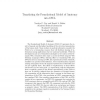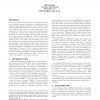159 search results - page 5 / 32 » Barriers to the use of OWL in Knowledge Driven Applications |
WS
2008
ACM
13 years 7 months ago
2008
ACM
The Foundational Model of Anatomy (FMA) [7] represents the result of manual and disciplined modeling of the structural organization of the human body. Many workers in medical info...
SEMWEB
2009
Springer
14 years 2 months ago
2009
Springer
Abstract. Semantic applications that utilise OWL ontologies can benefit from a broad range of OWL reasoning systems, which allow for the inference of implicit knowledge from expli...
ICTAI
2007
IEEE
14 years 2 months ago
2007
IEEE
The goal of Semantic Web research is to transform the Web from a linked document repository into a distributed knowledge base and application platform, thus allowing the vast rang...
SEMWEB
2007
Springer
14 years 1 months ago
2007
Springer
Abstract. Design patterns are widely-used software engineering abstractions which define guidelines for modeling common application scenarios. Ontology design patterns are the ext...
CBMS
2006
IEEE
14 years 1 months ago
2006
IEEE
— Most biomedical research databases contain considerable amounts of time-oriented data. However, temporal knowledge about the contextual meaning of such data is not usually repr...


